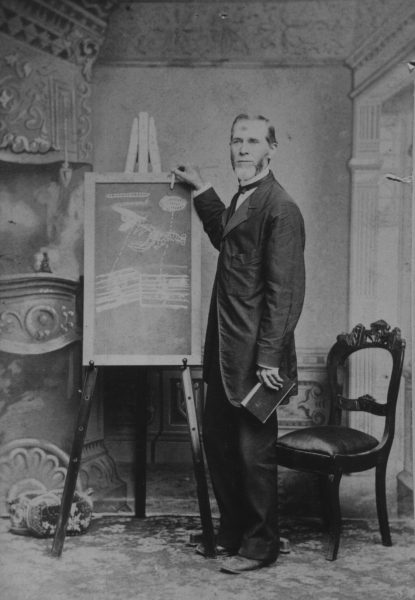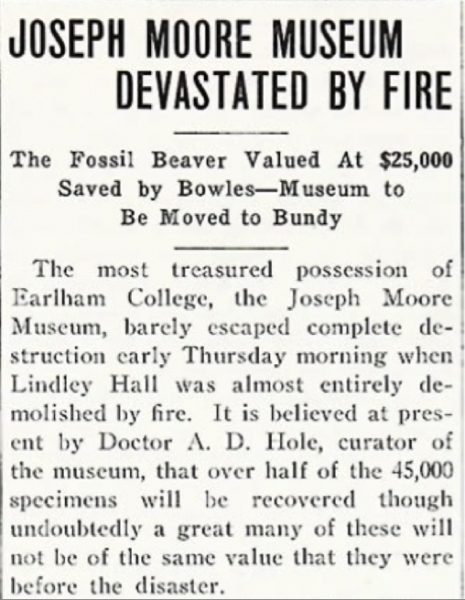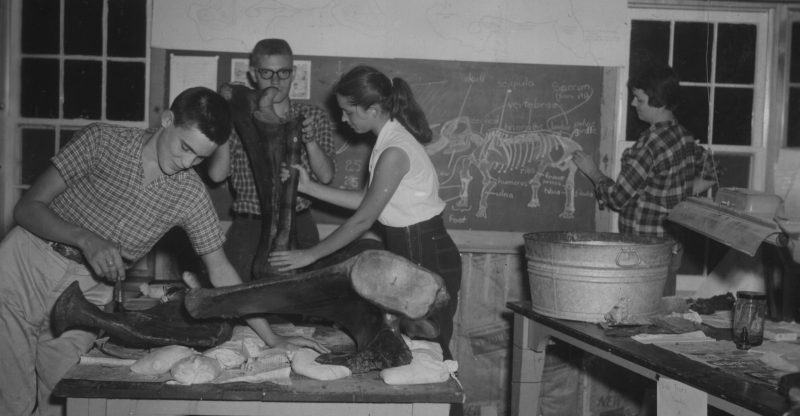JMM History
Today the museum is a vibrant center on campus. It is among the largest employers of students. Our teams keep the museum a vibrant place on campus by leading tours and programs, maintaining an active presence on social media, designing new exhibitions, and digitizing the collections. Read on to learn more about its history.
Joseph Moore was a teacher at the Friends Boarding School in Richmond, Indiana (later to become Earlham College) who collected natural history objects to supplement his teaching. At first, he housed his collection in a cabinet in Earlham Hall and later moved it to a small room. The collection was constantly growing and when Lindley Hall was built in 1887, the lower floor of one wing was designated for the museum. In 1889, the fossil Giant Beaver and Ta’an, the mummy, were acquired. Also during this time, the museum received the skeleton of “Tippo Sahib”, a local circus elephant that had gone mad and had to be shot. Its skeleton was mounted next to that of the mastodon. Attempts to catalog items were made, but like other museums of this time period, the total collection was on display as a jumble of objects. In 1905, after the death of Joseph Moore, Allan D. Hole followed him as curator. During Hole’s tenure, the Accession Books were started and the specimens were arranged more systematically.
Shortly after midnight on October 23, 1924, a night watchman noticed that Lindley Hall was on fire. Students helped remove specimens including the mummy after realizing the building was doomed. The giant beaver was carried out by Gordon Bowles ’25. The mastodon was saved from falling debris by a steel beam, and some of the mounted bird specimens survived because they were under a balcony. Amazingly, only about a quarter of the collection was destroyed, although among the losses was the skeleton of Tippo Sahib.
When Dennis Hall was completed in 1952, the museum moved into one wing which included storage for specimens not displayed while current research was used in exhibits to illustrate an idea to the visitor. Students began to take a more active role, and from 1952-1955 the staff, which was mostly composed of students, remounted the Randolph Mastodon in the new wing.
The story of the Randolph mastodon
What is referred to now as the Randolph Mastodon is actually a combination of remains of two mastodon skeletons, one found in Randolph County, Indiana, and one in New Paris, Ohio. The two skeletons, of comparable scale, were each discovered in the years prior to 1895. Thomas Pierson discovered one on the Ross Reed Farm near New Paris in September, 1873. The other was discovered on the Bookout Farm in the southwest corner of Randolph County sometime before 1895.
Mounting the Mastodon
Based on college records, Joseph Moore purchased part of the New Paris skeleton nearly 20 years prior to 1895 and donated them to the museum along with the rest of his collections. He worked to purchase more of the remains in the following years and requested funding from the board of trustees of the college to purchase enough remains to mount a complete skeleton. The board, in a June 1895 correspondence, expressed, “the most thorough and hearty sympathy with the object and with Professor Moore’s work… but way does not open to extend help at the present.” This did not deter Moore. Instead, he solicited funds from Richmondites and friends in Indianapolis to purchase more mastodon remains from New Paris and from Randolph County.
In the summer of 1895, he obtained enough parts to mount a complete skeleton, which he promptly did with the help of recent graduate Caswell Grave. Moore was dissatisfied with the mounting, however (he wrote of the mounted mastodon “not being sufficiently true to life”), took it down and rebuilt it during a vacation in 1896. In another report, Moore wrote that he was happy to announce that because his student assistant was willing to work on the project for very low pay, and due to many donations, “the entire purchase with all the labor bestowed has hardly cost the College the sum of ten dollars.”
(Read Joseph Moore’s article about the Randolph Mastodon in this article from the Proceedings of the Indiana Academy of Science)




